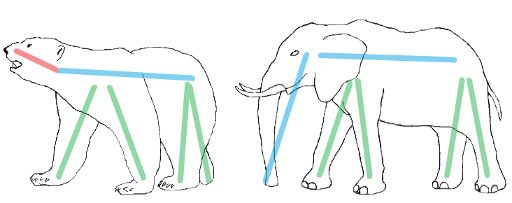Codeforces Round #269 (Div. 2) 总结
A
#include<stdio.h>
#include<string.h>
#include<algorithm>
const int maxm=110;
int vis[maxm];
int main()
{
memset(vis,0,sizeof(vis));
int x;
for(int i=0;i<6;i++)
{
scanf("%d",&x);
vis[x]++;
}
int ok=0;
for(int i=1;i<=10;i++)
{
if(vis[i]>=4)
{
ok=1;
vis[i]-=4;
break;
}
}
if(ok)
{
for(int i=1;i<=10;i++)
{
if(vis[i])
{
x=i;
break;
}
}
if(vis[x]==2)
{
printf("Elephant\n");
}
else
{
printf("Bear\n");
}
}
else
{
printf("Alien\n");
}
return 0;
}
B
It's time polar bears Menshykov and Uslada from the zoo of St. Petersburg and elephant Horace from the zoo of Kiev got down to business. In total, there are n tasks for the day and each animal should do each of these tasks. For each task, they have evaluated its difficulty. Also animals decided to do the tasks in order of their difficulty. Unfortunately, some tasks can have the same difficulty, so the order in which one can perform the tasks may vary.
Menshykov, Uslada and Horace ask you to deal with this nuisance and come up with individual plans for each of them. The plan is a sequence describing the order in which an animal should do all the n tasks. Besides, each of them wants to have its own unique plan. Therefore three plans must form three different sequences. You are to find the required plans, or otherwise deliver the sad news to them by stating that it is impossible to come up with three distinct plans for the given tasks.
The first line contains integer n (1 ≤ n ≤ 2000) — the number of tasks. The second line contains n integers h1, h2, ..., hn(1 ≤ hi ≤ 2000), where hi is the difficulty of the i-th task. The larger number hi is, the more difficult the i-th task is.
In the first line print "YES" (without the quotes), if it is possible to come up with three distinct plans of doing the tasks. Otherwise print in the first line "NO" (without the quotes). If three desired plans do exist, print in the second line n distinct integers that represent the numbers of the tasks in the order they are done according to the first plan. In the third and fourth line print two remaining plans in the same form.
If there are multiple possible answers, you can print any of them.
4 1 3 3 1
YES 1 4 2 3 4 1 2 3 4 1 3 2
5 2 4 1 4 8
NO
In the first sample the difficulty of the tasks sets one limit: tasks 1 and 4 must be done before tasks 2 and 3. That gives the total of four possible sequences of doing tasks : [1, 4, 2, 3], [4, 1, 2, 3], [1, 4, 3, 2], [4, 1, 3, 2]. You can print any three of them in the answer.
In the second sample there are only two sequences of tasks that meet the conditions — [3, 1, 2, 4, 5] and [3, 1, 4, 2, 5]. Consequently, it is impossible to make three distinct sequences of tasks.
#include<stdio.h>
#include<string.h>
#include<algorithm>
using namespace std;
const int maxm=1e4+10;
int vis[maxm];
int vit[maxm];
struct node
{
int h,id;
}t[maxm];
int cmp(node p,node q)
{
return p.h<q.h;
}
int main()
{
int n;
while(scanf("%d",&n)!=EOF)
{
memset(vis,0,sizeof(vis));
int ok=0;
int cnt=0;
for(int i=1;i<=n;i++)
{
scanf("%d",&t[i].h);
t[i].id=i;
vis[t[i].h]++;
if(vis[t[i].h]>=3)
{
ok=1;
}
if(vis[t[i].h]>=2&&!vit[t[i].h])
{
vit[t[i].h]=1;
cnt++;
}
}
if(ok||cnt>=2)
{
sort(t+1,t+1+n,cmp);
printf("YES\n");
int y=0;
for(int i=1;i<=n;i++)
{
if(i==1)
printf("%d",t[i].id);
else
printf(" %d",t[i].id);
}
printf("\n");
y++;
for(int i=1;i<=n;i++)
{
if(t[i].h==t[i-1].h)
{
if(y==3)
{
break;
}
swap(t[i].id,t[i-1].id);
for(int j=1;j<=n;j++)
{
if(j==1)
printf("%d",t[j].id);
else
printf(" %d",t[j].id);
}
printf("\n");
y++;
}
}
}
else
{
printf("NO\n");
}
}
return 0;
}
C
Polar bears Menshykov and Uslada from the zoo of St. Petersburg and elephant Horace from the zoo of Kiev decided to build a house of cards. For that they've already found a hefty deck of n playing cards. Let's describe the house they want to make:
- The house consists of some non-zero number of floors.
- Each floor consists of a non-zero number of rooms and the ceiling. A room is two cards that are leaned towards each other. The rooms are made in a row, each two adjoining rooms share a ceiling made by another card.
- Each floor besides for the lowest one should contain less rooms than the floor below.
Please note that the house may end by the floor with more than one room, and in this case they also must be covered by the ceiling. Also, the number of rooms on the adjoining floors doesn't have to differ by one, the difference may be more.
While bears are practicing to put cards, Horace tries to figure out how many floors their house should consist of. The height of the house is the number of floors in it. It is possible that you can make a lot of different houses of different heights out of n cards. It seems that the elephant cannot solve this problem and he asks you to count the number of the distinct heights of the houses that they can make usingexactly n cards.
The single line contains integer n (1 ≤ n ≤ 1012) — the number of cards.
Print the number of distinct heights that the houses made of exactly n cards can have.
13
1
6
0
In the first sample you can build only these two houses (remember, you must use all the cards):

Thus, 13 cards are enough only for two floor houses, so the answer is 1.
The six cards in the second sample are not enough to build any house.
#include<stdio.h>
#include<string.h>
#include<algorithm>
using namespace std;
#define LL long long
int main()
{
LL n;
while(scanf("%lld",&n)!=EOF)
{
LL sum=0;
for(LL i=1;;i++)
{
if(n<(3*i+1)*i/2)
{
break;
}
if((n+i)%3==0)
{
sum++;
}
}
printf("%lld\n",sum);
}
return 0;
}
